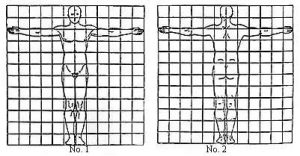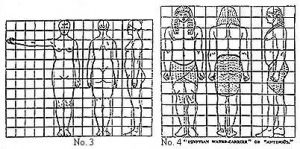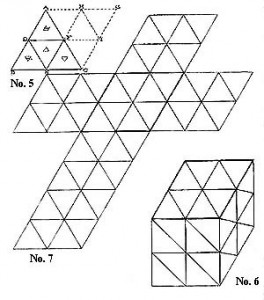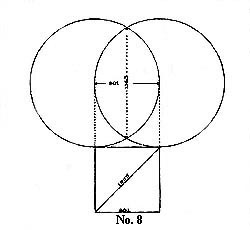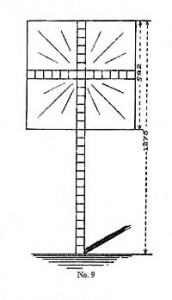By Frater Paracelsus
Sir John Maundeville, in the second chapter of his quaint book of “Travels” says: – “And you should understand, that the Cross of our Lord was eight cubits long, and the overthwart piece was of length three cubits and a half.”
Translating this thirteenth century description into modern measure at the rate of 18 inches to the cubit, we find the length of the Cross of Christ to have been 12 feet.
In the Revelation of St. John the Divine, Chapter XXI, we find it written: – “And he measured the wall thereof, and hundred and forty and four cubits, according to the measure of a man, that is, of the angel.”
Here we have clues, for one author gives 12 as a measure; the other gives the square of 12, or 144 as the measure. Acting on these hints let us draw a square of 12 and in it place the outline of a man. (Figure 1).
See how naturally the Human stands in the square, and how apparent the division both vertically and horizontally into three parts, each containing four parts of the whole square. The upper of these thirds crosses the pit of the stomach, the lower one crossing just over the knees. The upper sixth lies across the arms, the middle sixth centers at the generative organs, and the lower sixth cuts through the calves of the legs.
Examining the vertical lines it will be seen that the distance between the finger tips equals the height of the Man, also that the width of the body is closely equal to one sixth of the height, so that either half of the body equals one twelfth the height.
Looking at the Man from the back (Figure 2) we find similar correlation of the vertical and horizontal divisions.
In Nos. 3 and 4 the same method has been applied to the female body, and to the famous “Egyptian Standard,” known by the various names of the “Egyptian Apollo,” the “Water Carrier,” or the “Egyptian Antinous,” and it will be observed that in all positions the canon of twelve determines correctly the main proportions.
We shall now approach the subject from a symbolic viewpoint. Let us begin with the Tetragrammaton, No. 5. It is represented by the triangle A, B, C. Bisecting each side at the points D, E and F, and uniting these points we divide the triangle A, B, C into four smaller and mutually equal triangles. By placing within these triangles the signs of the Four Elements we have a symbol of physical man, the central flame within, enclosed by the chemical body.
This being man’s visible aspect, let us represent his invisible aspect by extending our figure to G and also forming the inner triangles by joining the points F, H and I. This extended figure, being in dotted lines symbolizes the finer and invisible aspect of man.
Man can be also represented by a Cube. Observing the completed figure of No.5 – A, B, C, G, we see that its outline is the same as the isometric projection of one face of a Cube. In Figure No. 6 we see such a Cube completed, and it will be seen that the upper, horizontal face, is the same as Figure No. 5 both in size and shape.
In order to observe all sides of this Cube at the same time, and remembering that it is not a solid, but a hollow figure, we will cut through seven of its 12 edges and unfold it onto a flat surface. Figure No. 7 gives us the unfolded Cube and it is seen to be the Cross in isometric projection.
Counting the number of the small triangles in this figure we find that there are 48. Remembering Man’s triune nature, body, soul and spirit, we multiply thus: –
48 x 3 and the result, 144, is the root of the decimal 144000, which is the Second Rosicrucian Sacred Number.
In the Tabernacle used by the Jews during their forty years wanderings in the Wilderness the most sacred and mysterious object was the ARK of the Covenant. Its length was 2 ½ cubits, or 45 inches; its breadth and height were each 1½ cubits, or 27 inches. The top, or Mercy Seat, on which was manifested the Shekinah, whence emanated the Bath Kol, was therefore 45 inches by 27 inches. The perimeter of the Mercy Seat was accordingly twice 45, or 90; plus twice 27, or 54; totaling the sum of 144 inches, thus giving again the mystic square of twelve.
We shall now briefly glance at the Kabala of the subject. We shall begin with the Greek word THEION, meaning Deity.
Let us now take Abraham, which in Greek is ABRAAM.
TH – 9
A – 1
E – -5
B — 2
I – 10
R-100
O – 70
A – – 1
N – 50
A — 1
M-40
144
145
Subtracting Colel* 145 – 1 = 144
The words ROSE and CROSS in Greek are RODON and STAUROS.
R -100
S – 200
O – 70
T – 300
D — 4
A – –1
O -70
U – 400
N -50
R – 100
294
O — 70
S – 200
1271
Subtracting Colel* 294 – 1= 293 and 1271 – 1 = 1270
RODON plus STAUROS is 293 + 1270 = 1563
Construct now a Vesica Piscis, (Fig. 8) in which this number, 1563, is the length of the Vesica. The corresponding width of the Vesica is 901. With 901 as a side, draw a square; the diagonal of this square will be 1275.
Let us now erect a Rood Cross with 1275 as its height, (Fig. 9). The ratio of the width to the height of a Rood Cross is as 13 to 28, which is nearly the same as the proportion given by Sir John Maundeville, that of 3½ to 8. Taking 13/28ths of 1275 gives 592 as the length of the cross arm. Now describing a square about the head of the Rood Cross with each side measuring 592 we have its total perimeter four times 592, thus: – 592 x 4 = 2368.
Referring now back to our discussions, we find 2368 to be the number of IESOUS CHRISTOS. Therefore upon the Rose Cross we find Jesus Christ mystically crucified within a square of 592.
* The Kabalistic Colel Rule states that one digit can be added to or subtracted from the gematria value of a word without affecting its value.

